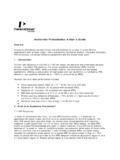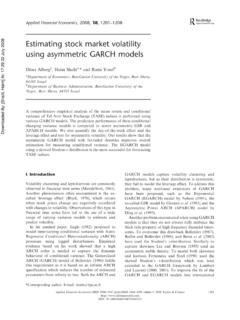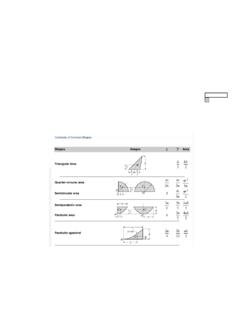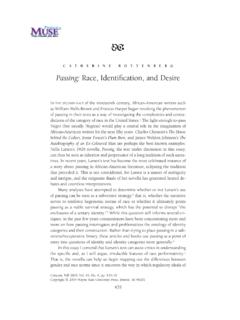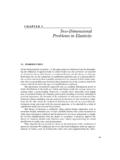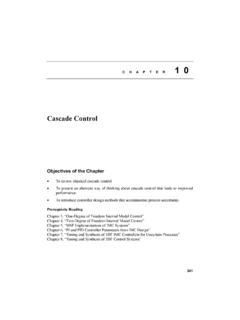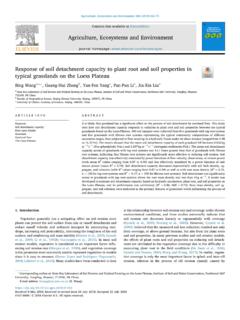Transcription of Agriculture, Ecosystems and Environment - BGU
1 agriculture , Ecosystems and Environment 193 (2014) 9 24 Contents lists available at ScienceDirectAgriculture, Ecosystems and Environmentj ourna l h om epage: of ecosystem responses to land-use change using soilquality and primary productivity in a semi-arid area, IsraelTarin Paz-Kagana, Moshe Shachaka, Eli Zaadyb, Arnon Karnielia, aThe Remote Sensing Laboratory and the Mitrani Department for Desert Ecology, Blaustein Institutes for Desert Research, Ben-Gurion University of theNegev, Sede Boqer Campus, Midreshet Ben-Gurion 84990, IsraelbDepartment of Natural Resources, Agricultural Research Organization, Gilat Research Center, Gilat 85280, Israela r t i c l e i n f oArticle history.
2 Received 15 December 2013 Received in revised form 12 April 2014 Accepted 24 April 2014 Keywords:Land-use changesEcosystem responsesSoil quality indexAboveground net primary productivityGrazingEcosystemsAgricultura l ecosystemNatural ecosystemNorthern Negeva b s t r a c tLand-use change (LUC) from natural to human-dominated land is a critical aspect of global change andecosystem response. To improve our understanding of LUC, this study focused on: (1) developing a generaltheoretical framework for quantifying and evaluating the attributes of ecosystem response as a conse-quence of LUC; and (2) testing the validity of this framework using recent LUC in the desert fringe of thenorthern Negev Desert.
3 Our framework is based on the premise that changes in soil and vegetation statesare the most important and universal facets of Ecosystems response to LUC. The framework depicts LUCas trajectories of indicators that signify soil and vegetation states, such as the soil quality index (SQI) andaboveground net primary productivity (ANPP), respectively, in a phase plane. The trajectories are char-acterized by both magnitude and the direction of the change that enable us to address and compare thegeneral trends of the LUC. Our study explored the validity of the proposed framework for the followingLUC cases: (1) grazing to natural ecosystem; (2) natural to grazing ecosystem; (3) rain-fed agricultural tonatural ecosystem; and (4) rain-fed agricultural to grazing ecosystem.
4 The SQI was quantified by 14 phys-ical, biological, and chemical attributes that were merged into one index, while the ANPP was derivedfrom biomass sampling. All transitions show strong relationships between SQI and ANPP ( < R2< ;p < ). Transitions from grazing to natural Ecosystems are characterized by an increase in both SQI andANPP variables; while all transitions that change from agricultural systems to less intensively managedsystems, such as grazing or a natural system, show no change or a decrease in both SQI and ANPP. We inferthat all the trajectories trends are a result of changes in the biodiversity dimensions during LUC.
5 Analysisof the results revealed four properties of a theoretical framework that can be used for the developingscience of LUC and ecosystem responses. Our framework enables: (1) a comparison between differenttypes of LUC; (2) a study of transitions among self-organized and managed Ecosystems ; (3) the identi-fication of short- and long-term effects; and (4) the integration of biodiversity and ecosystem suggest that the four properties of the framework can provide the foundation for the development ofan LUC science. However, the validity and the generality of the framework should be tested over a widerange of LUCs of terrestrial systems in the world.
6 2014 Elsevier All rights Land use changes: Conceptual frameworkThe term land use encompasses a wide range of human activi-ties on the land surface, such as grazing, agriculture , and urban use(DeFries et al., 2004). Land-use activities, whether converting nat-ural landscapes to human use or changing management practices Corresponding author. Tel.: +972 8 6596855; fax: +972 8 address: (A. Karnieli).on human-dominated lands, have transformed a large propor-tion of the planet s land surface (Foley et al., 2005). Worldwideobservations have confirmed that a large portion of the terrestrialsurface has been changed from natural Ecosystems to human-dominated Ecosystems , mainly to grazing and agro- Ecosystems ( Goldewijk, 2001; DeFries et al.)
7 , 2004; Foley et al., 2005; Zhouet al., 2006; de Chazal and Rounsevell, 2009). The transitions inland-use activities are largely due to demographic and economiccauses and are expected to increase over time. Different parts ofthe world are at different transition stages, depending on their his-tory, social and economic conditions, and ecological context. Thetype of land-use change (LUC) significantly affects key aspects 2014 Elsevier All rights T. Paz-Kagan et al. / agriculture , Ecosystems and Environment 193 (2014) 9 24ecosystem responses, in terms of ecosystem structures, functions,and dynamics, and creates new complex interactions among soil,nutrients, and vegetation that determine the ecosystem health(Adeel et al.
8 , 2005). These responses vary not only according to thestate of LUC, but also with the biophysical and ecological setting(DeFries et al., 2004; Foley et al., 2005) due to the modificationsof biodiversity, productivity, and soil quality (Matson et al., 1997;Tscharntke et al., 2005).Historically, LUCs of natural environments to rangelands and,later, to croplands are known from the beginning of human settle-ment as a consequence of the domestication of plants and animals,and of land cultivation, and this type of ecosystem transformationbecame the most common on earth (Goudie, 2009).
9 During the last300 years, the global area of agricultural land has increased from256 Mha in 1700 to 1471 Mha in 1990, and it currently occupiesbetween 24% and 38% of the Earth s land surface (Goldewijk, 2001;Swinton et al., 2007). In addition, the global amount of pasture landhas also increased from 524 Mha in 1700 to 3451 Mha in 1990, andit occupies around 25% of the global land surface (Asner et al., 2004).Previews studies show the important role of ecosystemresponse to LUC due to modulation of the biosphere by changes inbiogeochemical, biodiversity, hydrological, and climatic responses( DeFries et al.)
10 , 2004). However, more theoretical and empir-ical work is needed in order to manage these human-controlledbiospheres (Foley et al., 2005). Land use change models that incor-porate ecosystem processes, dynamics, and responses can help toadvance our understanding of the ecosystem-level consequencesof LUC and their sustainable management. In this study, we aim at:(1) developing a theoretical framework for evaluating the changesof ecosystem response to LUC; and (2) demonstrating the validity ofthe framework using LUCs in the northern Negev Desert as a casestudy. We propose that the transitions between natural, grazed,and agricultural Ecosystems , which include the human activities ofland cultivation and replacement of the natural vegetation and ani-mals by domesticated organisms (Tscharntke et al.

